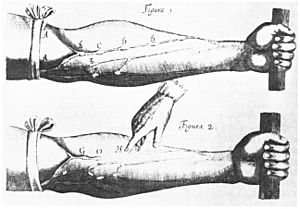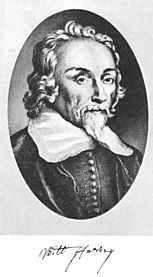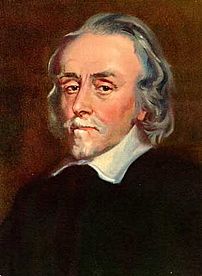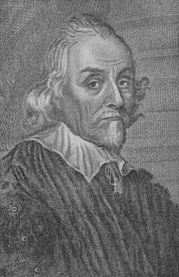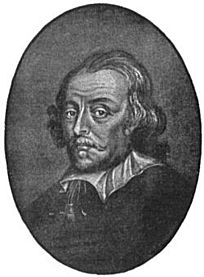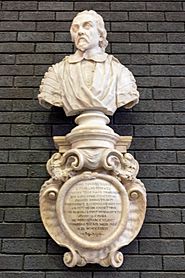William Harvey facts for kids
Quick facts for kids
William Harvey
|
|
|---|---|
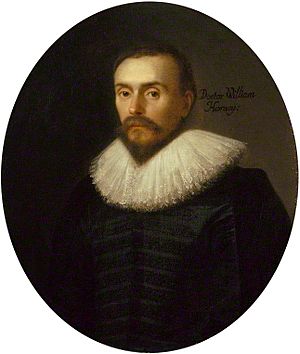
Portrait attributed to Daniël Mijtens, c. 1627
|
|
| Born | April 1, 1578 Folkestone, Kent, England
|
| Died | June 3, 1657 (aged 79) Roehampton, London, England
|
| Education | Gonville and Caius College, Cambridge University of Padua (M.D., 1602) |
| Known for | De Motu Cordis, 1628 (translated as Anatomical Account of the Circulation of the Heart and Blood in 1928) on systemic circulation |
| Scientific career | |
| Fields | Medicine Anatomy |
| Doctoral advisor | Hieronymus Fabricius |
| Influenced | René Descartes |
| Signature | |
 |
|
William Harvey (April 1, 1578 – June 3, 1657) was an English physician who made discoveries in anatomy and physiology. He was the first known physician to describe completely, and in detail, how blood is pumped to the brain and the rest of the body by the heart.
Contents
Early Life and Education
William was the oldest of nine children, seven sons and two daughters, of Thomas and his wife Joan Halke. William's father, Thomas Harvey, served as the mayor of Folkestone.
William learned Latin as a child in primary (elementary) school in Folkestone. His secondary schooling was at the King's School (Canterbury). He stayed there for five years and then went to Gonville and Caius College, Cambridge in 1593.
Harvey graduated with a Bachelor of Arts degree from Caius in 1597. He then traveled through France and Germany to Italy, where he entered the University of Padua, in 1599. While he was there, he developed a friendship with Fabricius and read Fabricius's De Venarum Ostiolis, which influenced his love of anatomy. Harvey graduated as a Doctor of Medicine at age 24 from the University of Padua on April 25, 1602.
Doctoral positions and marriage
Harvey returned to England to practice medicine and joined the Royal College of Physicians on October 5, 1604.
A few weeks after his admission into the RCP, Harvey married Elizabeth Browne, "daughter of Lancelot Browne Dr. Physic" (a medical doctor). They had no children.
Harvey was elected a Fellow of the Royal College of Physicians on June 5, 1607. This allowed him to place the letters FRCP with his M.D. suffix after his name. He then accepted a position at St. Bartholomew's Hospital, where he would work for most of the rest of his life.
On August 4, 1615, Dr. Harvey was given the position of Lumleian lecturer. The Lumleian lectureship was founded by Lord Lumley and Dr. Richard Caldwell in 1582. Its purpose was to give lectures that "spread light" and increase the general knowledge of anatomy throughout England. The notes Dr. Harvey used for his lectures are preserved in the British Museum.
Physician to James I
Dr. Harvey continued to give the Lumleian lectures and care for his patients at St. Bartholomew's Hospital. His career caught the eye of King James I, and on February 3, 1618, Harvey was given the position of 'Physician Extraordinary' to the king.
Publications, travel, and work
In 1628, he published his completed essay on the circulation of the blood, the De Motu Cordis. Other doctors did not agree with this new idea and criticized him for it. He did keep his position as "Censor" of the College of Physicians and was eventually elected Treasurer of the College.
When Harvey was fifty-two, the king commanded him to go with the Duke of Lennox during his trip abroad. The trip lasted three years. They traveled through France and Spain during the Mantuan War and Plague.
He returned to England in 1632 and became the household physician of King Charles I. During this time, the English Civil War broke out and Harvey helped the wounded. The war led King Charles to Oxford, and Harvey went with him. Harvey was made "Doctor of Physic" in 1642 and later Warden of Merton College in 1645.
Harvey's later years, death and burial
By 1645, Harvey was sixty-eight years old and childless. He had lost three brothers and his wife and had retired from St. Bartholomew's Hospital and his other positions.
Harvey died at Roehampton in the house of his brother Eliab on June 3, 1657. He left his belongings and money to his extended family and the Royal College of Physicians in his will. He was buried in St. Andrew's Church in Hempstead in northern Essex.
De Motu Cordis
In 1628, Dr. Harvey published his 72-page Exercitatio Anatomica de Motu Cordis et Sanguinis in Animalibus, which explains how blood circulates in the body. Harvey had studied many animals and realized that blood was pumped through the heart in a single system of arteries and veins. Harvey predicted that people would be skeptical and mock him for his "new" theory. He was correct. It took about twenty years for his theory of the circulation of the blood to be generally accepted.
Before Harvey, Galen had been the medical authority for centuries. He believed (and therefore, most scientists believed) that the veins and arteries were two separate systems. He believed that the heart produces heat while the arteries cool blood as the lungs "...fanned and cooled the heart." Years before, a few scientists discovered and wrote the same findings Harvey did. However, their findings were either lost or discounted. These scientists include Ibn al-Nafis and Michael Servetus.
On Animal Generation
Harvey's other major work was Exercitationes de generatione animalium (On Animal Generation), published in 1651. In this book, he describes how a hen's egg develops. He moves on to show that omne vivum ex ovo (all life comes from the egg). Some eggs are laid and hatched outside the mother's body (oviparous), and some eggs are fertilized and remain in the mother resulting in a live birth (viviparous). He showed that the previous theory of spontaneous generation is false.
Legacy
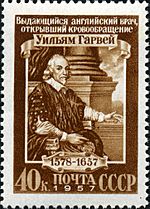
Harvey's whalebone demonstration rod, tipped with silver, is on display in the silver room of the museum of the Royal College of Physicians. He used it to point to objects during his lectures.
Several medical facilities, institutions, medical societies, and clubs are named after him. His hometown of Folkestone, Kent also has a statue of him. The Royal College of Physicians of London holds an annual lecture established by William Harvey in 1656 called the Harveian Oration.
William Harvey quotes
- “All we know is still infinitely less than all that remains unknown.”
- “Nature is a volume of which God is the author.”
- “Only by understanding the wisdom of natural foods and their effects on the body, shall we attain mastery of disease and pain, which shall enable us to relieve the burden of mankind.”
- “For the concept of a circuit of the blood does not destroy, but rather advances traditional medicine.”
- “No human being may acquire knowledge without diligence.”
Interesting facts about William Harvey
- William had six brothers and two sisters. Of his brothers, five became successful London merchants.
- While at the University of Padua, Harvey attended lectures in the anatomical theater built in 1594. It still stands today. It is a small room, about twenty-five by thirty feet in size. There is an oval pit in the middle where the professor speaks and demonstrates.
- Hieronymus Fabricius, one of Harvey's teachers and later a friend, had already discovered the one-way valves in veins but was not sure of their purpose. Harvey later proved that they prevent blood from flowing backward.
- One of Harvey’s main experiments was about the amount of blood flowing through the heart.
- Before Harvey’s discoveries, Western doctors still believed that the liver was the source of blood movement around the body.
- His wife Elizabeth Browne was the daughter of Dr. Lancelot Browne, the physician to Queen Elizabeth I, King James I, and Queen Anne of Denmark.
- King Charles I took a personal interest in Harvey’s research in circulation and growth, and he provided Harvey with animals for his experiments.
- In Harvey’s later life, he suffered from gout, kidney stones, and insomnia.
Images for kids
-
William Harvey, after a painting by Cornelius Jansen
-
Bust of William Harvey at the Royal College of Physicians, London
See also
 In Spanish: William Harvey para niños
In Spanish: William Harvey para niños
- Miguel Servet
- Amato Lusitano – Portuguese 16th-century physician, also credited with the discovery of the circulation of the blood
- Josephus Struthius
- Scientific revolution
- List of multiple discoveries


